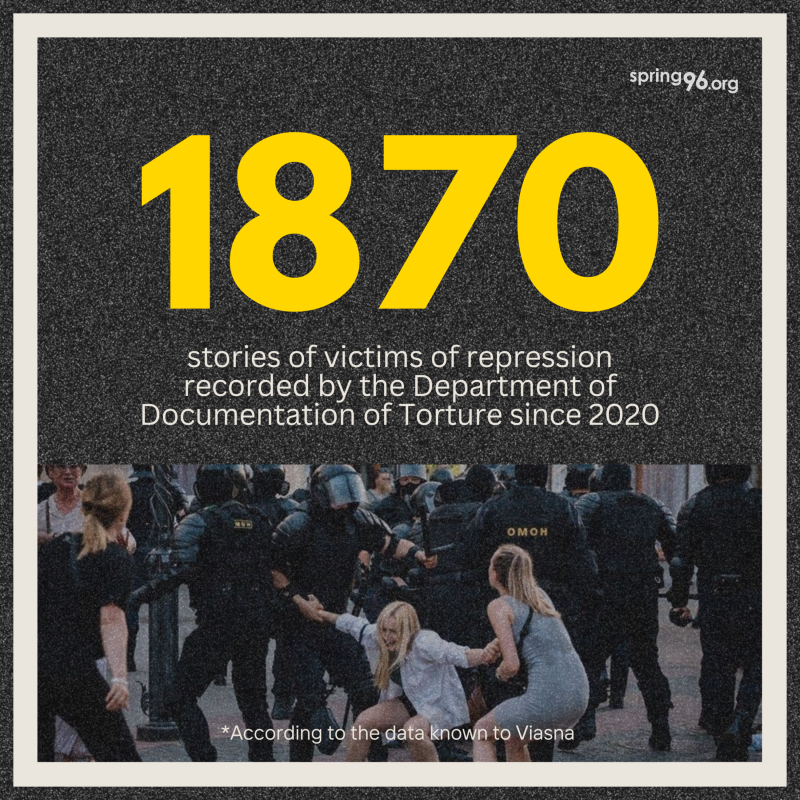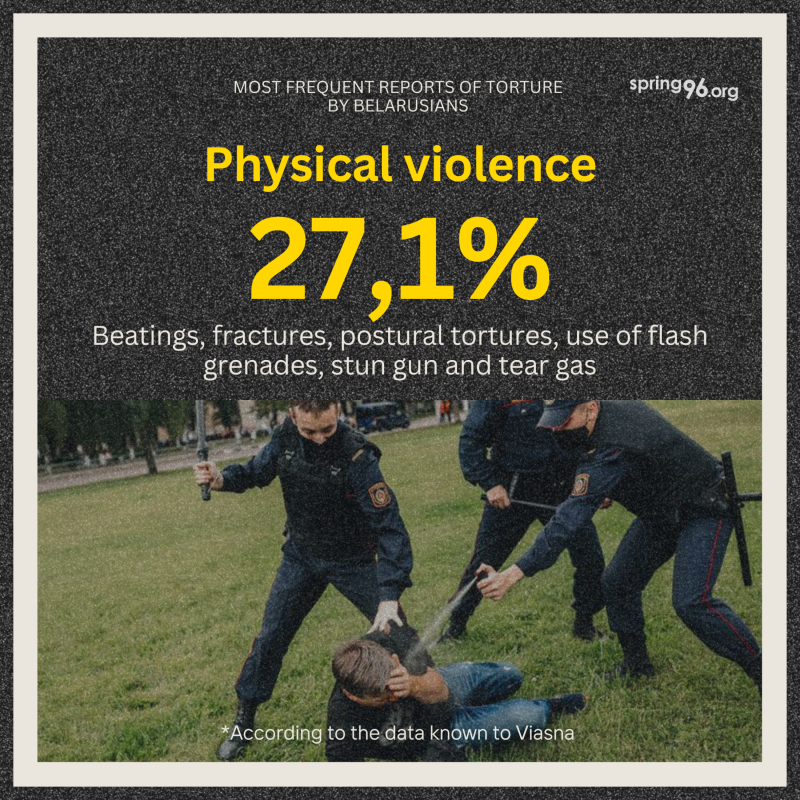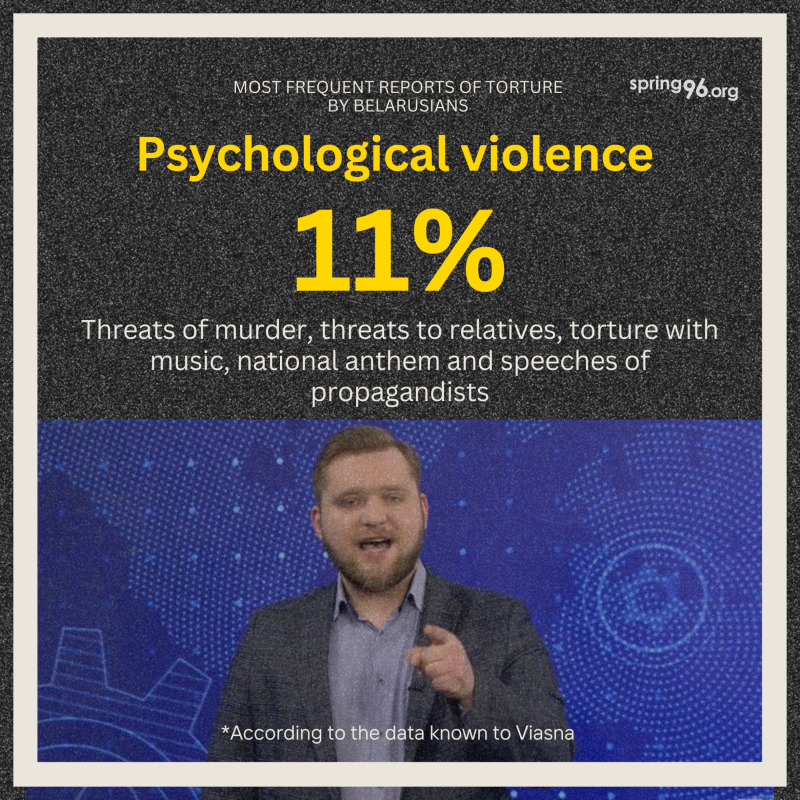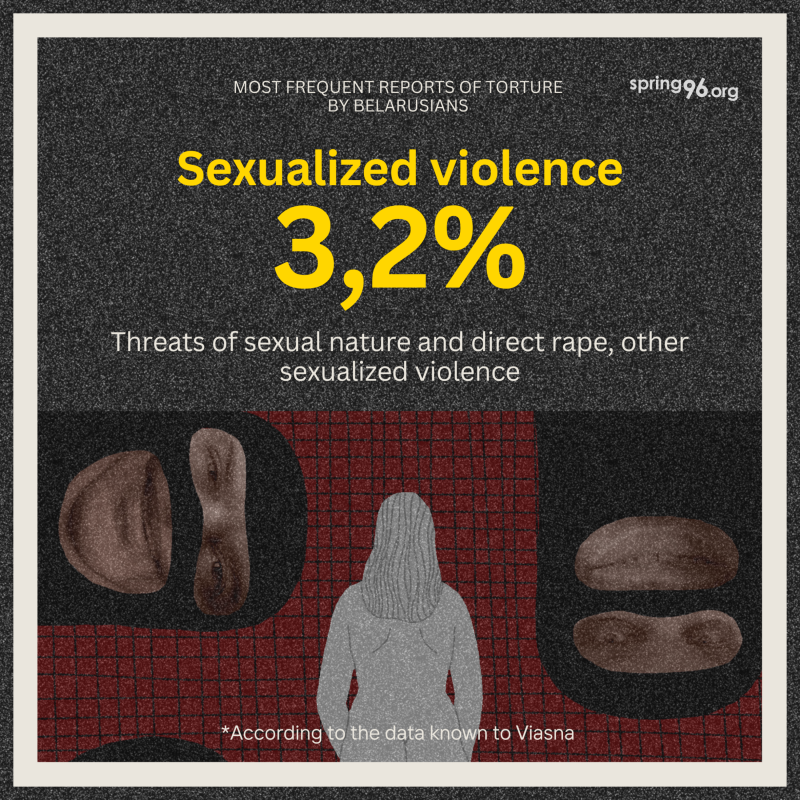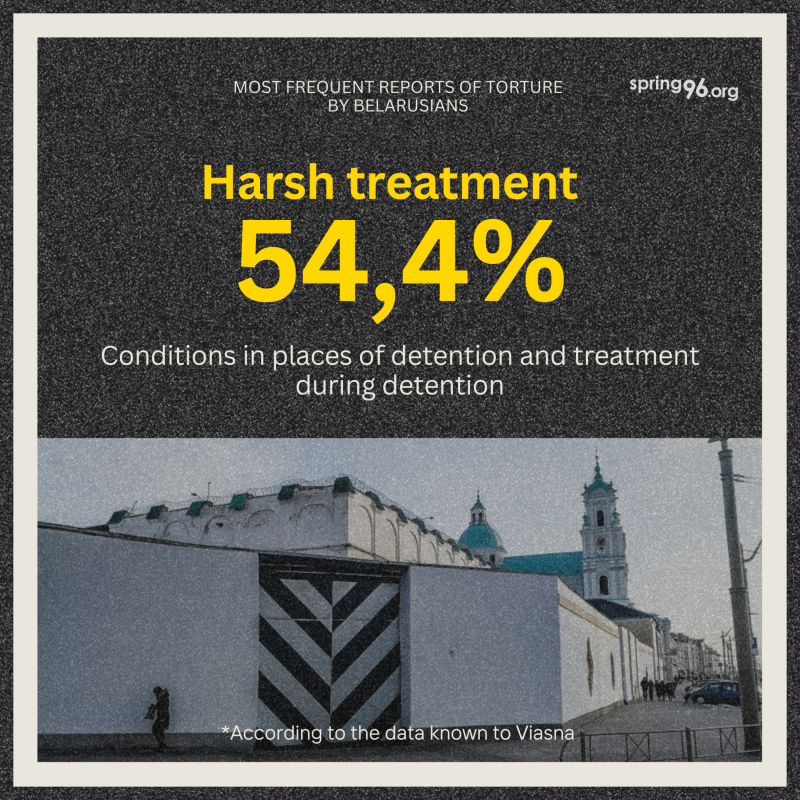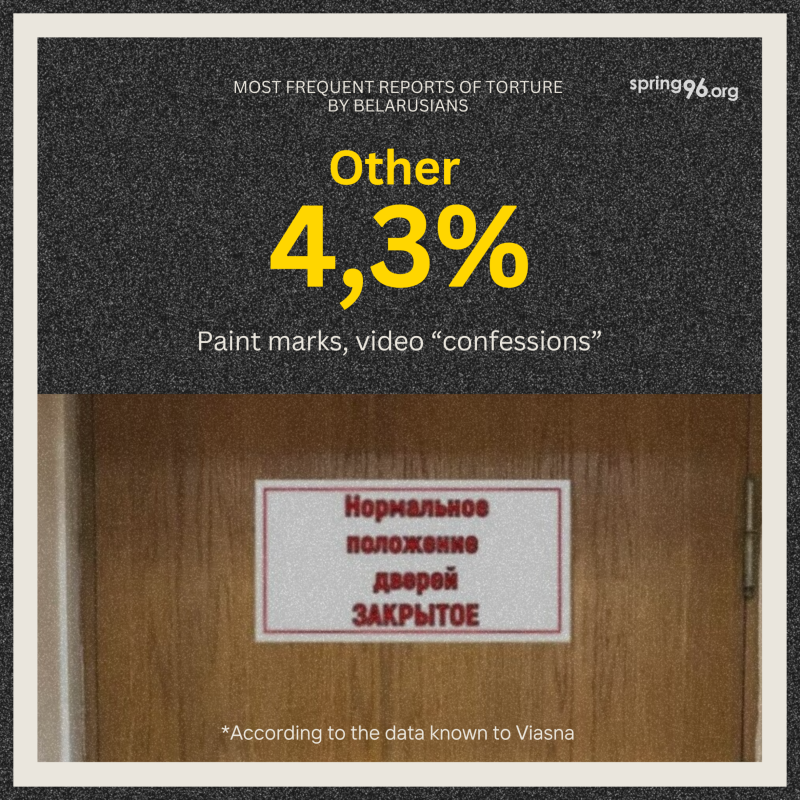Beatings, threats, inhuman conditions: what tortures Belarusians most often tell about. Statistics
The repression of Belarusian men and women who oppose the Lukashenka regime continues for the fourth year in a row. The Torture Documentation Department of Viasna, the Human Rights Center, and DIGNITY, the Danish Institute Against Torture, have been documenting various cases of torture and cruel and inhuman treatment for all these years. Victims of repression tell the documenters about violence in police stations and places of detention, during arrest, investigation and while serving their sentences. In places of detention, prisoners are regularly subjected to physical, psychological and sexualized violence, and often face inhumane conditions of detention.
On the anniversary of the post-election protests in Belarus, we highlight the most common cases of torture reported by victims of repression to human rights defenders.
"Victims had the courage to speak out about human rights violations"
In 2020, in response to the mass repression, Viasna created the Torture Documentation Department. At the same time, a permanent cooperation with DIGNITY, the Danish Institute Against Torture, began in order to collect evidence of torture in Belarus. Later, based on the experience of their Danish colleagues, the employees of the department developed a system of special tags to mark and systematize the stories of the oppressed. Since 2020, the Torture Documentation Department has recorded 1,870 stories of victims of repression. According to human rights activists, at the beginning of the documentation process, the stories could be several tens of minutes long. Now, the interviews are conducted according to international standards and have become much more detailed. The longest interview, for example, lasted about 12 hours. All the details are recorded, which may become important evidence in the future to bring the perpetrators of repression to justice.
Human rights defenders note that there may be many more victims of torture and ill-treatment than the Torture Documentation Department has collected so far. Some witnesses refuse to talk about torture, either for safety reasons or because they do not want to recall painful experiences. However, the testimonies collected already help to illustrate the extent and variety of the repressions to which Belarusians in custody are subjected.
Teresa Reiter, Chairwoman of the Dignity Danish Institute, shared her impressions of documenting torture in Belarus:
"I was impressed by the courage and resilience of the survivors of human rights violations in Belarus. We documented thousands of cases of abuse, including beatings, sexual and gender-based violence. Despite the risk of reprisals for seeking justice, survivors had the courage to speak out about human rights violations, to share information about the brutality they had suffered, so that these violations could be documented and serve the cause of justice. Despite the intense pain and suffering experienced by the victims of arbitrary arrest, detention and ill-treatment, they demonstrated impressive resilience and a strong desire to seek justice".
The human rights defenders divided the testimonies of reprisals into physical violence, including beatings, fractures, and postural tortures; psychological violence: death threats, threats to relatives, torture with music and speeches of propagandists; and sexualized violence. And they added the category of cruel and inhuman treatment, which mostly included multiple descriptions of detention conditions. The data are presented as percentages.
In a recent article, Viasna detailed the types of torture in Belarusian prisons. In this article we highlight the cases most often reported by the victims themselves.
"They were beaten so hard that you could hear the crunching of bones". Physical violence
According to Viasna's Torture Documentation Department, testimonies of various cases of physical violence account for 27.1% of the total number of stories. This category includes beatings and their consequences (injuries, bruises, fractures, head trauma, "corridor" of truncheons), postural torture (stretching, forced positioning), use of special means (rubber truncheons, flash grenades, stun gun, tear gas).
Since the beginning of the post-election protests in August, Belarusians have been confronted with constant manifestations of physical violence on the part of law enforcement officials. In the early days of the August protests, law enforcement officials threw flash-bang grenades at demonstrators and fired rubber bullets at close range. Thus, late in the evening of August 10, during the protest action in Minsk near the Pushkinskaya metro station, law enforcement officers shot and killed Aliaksandr Taraikouski. He was the first protester to be killed by a law enforcement officer.
Many people were seriously injured. At the same time, on August 10, near the Pushkinskaya metro station, Heorhi Saikouski had part of his foot torn off by shrapnel from a flash-bang grenade. On the night of August 9-10, 2020, a flash-bang grenade exploded near political prisoner Andrei Papou, a fragment of which hit him in the face, cutting his cheekbone. A rubber bullet also hit him in the leg.
Those who disagreed with the actions of the authorities were subjected to torture in the form of brutal beatings in police stations and detention centers. Our colleagues at the International Committee for the Investigation of Torture, who also document cases of repression, have published an investigation about the horrific beating of protesters at the Maskouski police station in Minsk on August 9-13, 2020, as well as investigation about torture at the detention center on Akrestsina Street during the same period.
"The cruelest thing was when I woke up at one o'clock in the morning and heard people screaming. Men were being beaten so hard that you could hear the crunching of bones, and the screams were so loud that it was as if people were being burned. Grown men were screaming, "Mama, help! Save me!"
Despite the fact that cases of heinous torture have been widely reported by the Belarusian mass media and the world community, Belarusians continue to be severely beaten while in custody.
"As soon as they took me out of the office, I got hit. They put me in a car, handcuffed my hands behind my back, and started torturing me. A riot policeman punched me in the face and threatened to break my nose. The KGB officer had narrow pupils and looked as if he was under the influence of some substance. He kept telling me: "I'm not beating you, I'm treating you well," and at that moment he was putting fingers under the clavicle bone and twisting the skin on my chest. He pulled my ear really hard and eventually tore it. It took several months to heal," the former political prisoner said.
Those who disagree with the administration's actions are also beaten in places of detention.
A former political prisoner who served his sentence in Viciebsk Colony No. 3 recounted how the head of the colony, Filip Sturchanka, and his deputy, Dzianis Fedchanka, personally came to beat political prisoners who openly spoke out against the colony administration and its procedures.
"One day, prisoner Mikalai Shkaliar washed in the shower with me. He was blue from head to toe from a beating. He hardly manged to come into the shower room. I've heard before that someone was severely beaten in the colony. And it was him. "Sturchanka held a baton in both hands and beat me so hard, as if he wanted to cut me in half," Shkaliar told me."
Another common form of physical violence is so-called torture by posture, which is actively practiced, for example, in pre-trial detention facilities.
During the inspection, prisoners are forced to "stretch": to stand with their legs apart for a long time. If a person does not do this, he or she is hit hard with a stick on the inside of the legs. This position is very uncomfortable. Even elderly people who are not physically fit are forced into this position.
"The floor in the corridor is tiled, each tile 30 centimeters wide. We were told to spread our legs across the width of five tiles - one and a half meters. If we couldn't fit that much between our legs, we were beaten hard on our legs to make them spread apart," the former political prisoner testified about Žodzina prison.
Men and women, even those of retirement age, were tortured with this pose. One former political prisoner recounted her experience.
"In the corridor they they made face the wall, they put a baton on our shoulders and started beating us. With one hand holding the baton, the guard presses your head against the wall, and with the other hand she beats you.
To make us spread our legs, the women kicked us on the foot with a boot. It was very difficult for older and smaller women to stand in this position. Next to me was a prisoner who had arthritis. She could not spread her legs that far apart. So she was kicked hard on the leg. The woman almost fell down."
Former political prisoner and rock musician Anton Maslyka, who spent almost a year and a half behind bars, spoke about the inhuman poses in which prisoners were held.
"When we were in the detention center, everyone said: "I'd rather go to Valadarka - it will be easier there. But when we were taken there, we were immediately lined up against the wall in a "G" position. You could not put your head on the wall - you had to stand with your hands behind your back. And okay, I was still young and physically fit, but there were older people among us who found it difficult. We were kept in that position for two hours. Everything was cramping, both hands and back. There was a man in his 50s standing next to us - he was sweating."
Political prisoners are also taken into the corridor of the remand center and forced to squat or hold heavy objects on their outstretched arms, such as a twisted mattress, until they are exhausted.
"Once, during an inspection, we were ordered to squat. One political prisoner, a pensioner, couldn't hold on and fell. They only stopped making us squat when the woman cried."
The documenters have received many testimonies of political prisoners being forced into the "swallow" position: the prisoner's head is tilted very low and his hands are tied behind his back. It is often in this position that prisoners are transferred from cell to cell.
"We were always handcuffed from behind. In the detention center, we were always led only in a "swallow" position. I began to have very serious problems because of this. I had a psychological block, I refused to bow down, and this led to a serious conflict. On the last day I was afraid that they wouldn't let me out. After all, they threatened to use special means against me, to draw up a protocol for "disobedience to the police". And because of my refusal, they kept pinning me down and leading me in this way, that is, using physical force."
"The more we shouted, the louder they turned up the radio for us". Psychological abuse
The next category is 11%. It includes threats to political prisoners of beatings and murder, threats to their relatives; so-called torture with music, the national anthem, and speeches by propagandists.
A former political prisoner tells about the daily listening to the speeches of Lukashenka and the delegates of the All-Belarusian People's Assembly in the cell of Žodzina prison:
"At first they turned it on every day. And the more we shouted on the radio, the louder they turned it on. It got to the point where we couldn't hear each other. Then we stopped talking because it was useless.
Lukashenka (his speeches - ed.) was often played. I don't know what kind of torture they use. But they certainly know how to torture. A kind of circus."
Law enforcement officials often use threats of physical violence against detainees to induce them to confess guilt or to further humiliate and intimidate a person.
For example, a former political prisoner in the "Zeltser case" was threatened with violence by KGB officers for writing a comment about their dead colleague.
"At first I couldn't understand why they had come for me, and I played dumb. And when they asked me: "Well, who's going to piss and shit there?", I realized that I was being detained for a comment I had written about a KGB officer who had broken into Andrei Zeltser's apartment. I didn't deny it, I immediately admitted that I had indeed written it. Then they started threatening me: "You've never had your balls pinched before, have you? We're coming to the police station and you'll find out what it is". When I got to the station, they put me on my knees in the hallway. I stood there for about an hour."
Law enforcement officials also harass close relatives of detainees, for example, in order to "extort" false testimony. Singer Meryem Herasimenka, a political prisoner, told how her boyfriend was beaten by four officers of the State Department for Combating Organized Crime in order to incriminate Meryem.
"My Anton was deported from the Republic of Belarus a year and a half ago because he refused to give "false testimony" against me, that allegedly the funds received from my street concert at the bar Banki-Butylki in August 2022 were transferred to sponsor and finance the Ukrainian Armed Forces.
... Anton was beaten by four representatives of GUBOPiK, they locked him in the office, up to his purple feet, they put me at the door so that I could hear how a man was being harassed just because he refused to say a false denunciation of me and the fact that he was my young man!"
The families of those sentenced to "home chemistry" are also under pressure. Former political prisoner Tsimafei told Viasna about such a case.
"The police came again, but this time not more than three times a week and not later than 9 pm. They can come on Saturday and remind us of the meeting, and then again on Sunday. It's all very nerve-wracking, and they put pressure not only on the political prisoners, but also on their families. The parents' committee kept coming to the house of a "political" prisoner to check on the conditions of the children, and his wife was harassed at work."
"Our data confirm the rape of prisoners". Sexual violence
This category represents 3.2%. It mainly includes stories of threats of rape.
"A female staff member asked: "Put these guys on your truncheons," one of the affected protesters testified about torture in the detention center on Akrestsina Street.
After the mass repression in 2020, victims told human rights activists about repeated threats of sexual violence during their imprisonment. And according to the report of the UN High Commissioner for Human Rights Michelle Bachelet, there are known cases of sexual violence in Belarus.
"Our findings confirm the rape of detainees and other forms of sexual and gender-based violence against both men and women. Medical records reviewed by OHCHR indicate the presence of trauma to the male genitalia. Detainees were also subjected to psychological pressure, including threats of rape."
"Inhuman conditions for a man to lose his identity". Ill-treatment and detention conditions
The largest category is with 54.4%. Descriptions of terrible and inhumane conditions in places of detention make up the vast majority of this category. Most often, the former political prisoners mention the lights in the cell that are not turned off at night, the lack of mattresses and sleeping on iron bunks, the blocking of communication with relatives by the prison guards, the lack of showers and washing facilities, the lack of fresh air in the cells, cold torture and overcrowded cells.
Former political prisoner and journalist Volha Klaskouskaya commented on the conditions in Homieĺ Colony No. 4.
"These inhuman conditions are all very elaborate, to completely pull the ground out from under your feet, so that a person loses his identity, breaks down, collapses in spirit. Everything is done to paralyze your will, to wipe out any thought of resistance. To make you feel weak, inferior, helpless, guilty, because such people are easier to manage and manipulate, easier to control."
Former political prisoner Zakhar Yanouski recalls the conditions of detention in the detention center on Akrestsina.
"It was already a single cell with a concrete floor, where there were 9 depressed people who had just received a criminal record. Some were grabbing their heads in shock, some of them had wedding plans. It was cold at night on the concrete, and to avoid getting sick, I put a broom under my body. It was also cramped, people were lying on the floor like Tetris, you couldn't move. It was impossible to sleep."
Former political prisoner Ihar Fiodarau told about the cold torture in the SHIZO cell at the end of November.
"Thank God, this time there were three of us in the cell. But it was very cold. During the day it was normal, because the heaters were on. At night the warden would open the windows a bit and the icy wind would blow all the heat out in half an hour. The cell cooled down to 10 degrees. We were dressed in the so-called "glass" - a thin uniform made of synthetic fabric with SHIZO written on the back.
I breathed into the towel, and the warmth of my breath warmed my face, nose, and ears. It's like wearing a balaclava, except your face is completely covered. If you don't fall asleep in the first five minutes, the cold will keep you awake all night. Unless you take short naps of 10-15 minutes, you can get some rest."
Paint marks and video "confessions". Other forms of cruel and inhuman treatment
Violence such as paint marks, video "confessions", and dog baiting fall into this category.
During the mass arrests of demonstrators after the presidential election, a common violent practice of the security forces was to mark people with paint. In detention cells and police stations, detainees were painted different colors on their hair, clothes, skin, and faces to indicate the degree to which they were to be beaten.
Stas Dzedau, a resident of Minsk, told Viasna how he was marked with paint in the detention center in August 2020.
"One person was already lying in the detention center. They put me next to him, and on the way they beat me a little with batons. Then they took me out, took a bottle of white paint and poured it on my head. They took me by my hair and wiped the paint off the bus with my head. After that, they sent me to another car where a lot of people were already lying flat on top of each other. I was on the floor.
There were at least two more transfers between cars. During the transfers we were beaten. The OMON officers recognized me by the white paint in my hair - it was a sign: we should treat this person more harshly. They themselves openly said that they had "marked" him."
The practice of so-called "confession" videos began to be actively used by law enforcement agencies in 2021. The videos are recorded by law enforcement officers of various agencies: both employees of the Main Department of Internal Affairs and police officers. In the video, detainees are forced to incriminate themselves and apologize. It is often seen that people speak a memorized text. According to victims, law enforcement officials often record the video in several takes to get the desired image. In the "confession" videos, detainees may look badly beaten.



